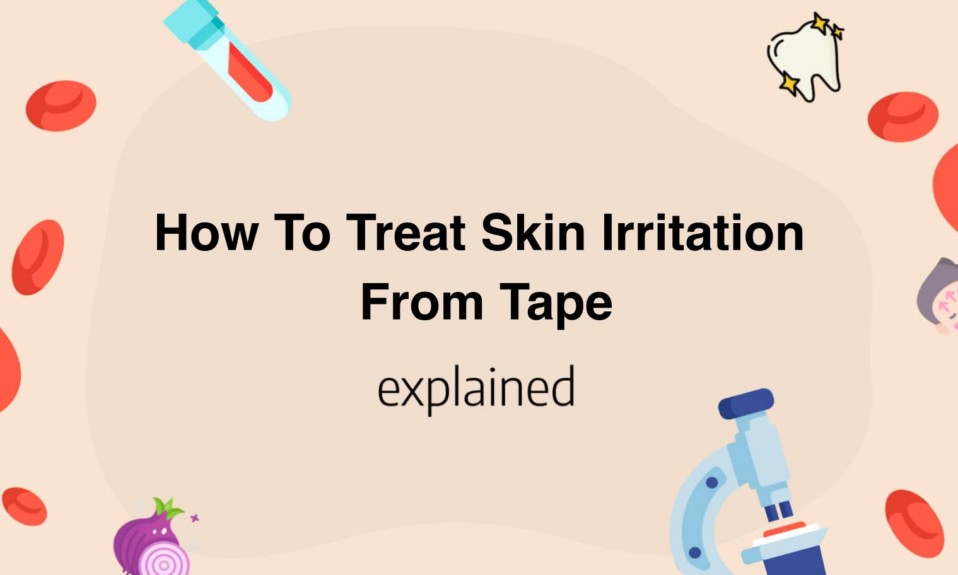If you’ve experienced skin irritation from bandages or medical tape, you know how uncomfortable and frustrating it can be.
Tape irritation is a common issue that can cause redness, itching, and even blisters.
Fortunately, there are several effective solutions for treating this problem, including using gentle adhesive removers, keeping the affected area clean and dry, and applying soothing creams or ointments.
With the right approach, you can relieve your tape irritation and get back to feeling comfortable and confident.
- Avoid using adhesive tape on irritated skin.
- Remove any tape that is causing irritation as soon as possible.
- Clean the irritated area with mild soap and water.
- Apply a moisturizing cream or ointment to the affected area.
- If the irritation is severe or does not improve, consult a healthcare professional for further treatment options.
How To Treat Skin Irritation From Tape
If you’re one of those unfortunate people who get skin irritation from tape, you know how annoying and frustrating it can be.
Fortunately, there are several ways to treat tape-related skin irritation.
One of the simplest and most effective ways is to use a gentle adhesive remover.
A gentle adhesive remover dissolves the adhesive on the tape, allowing you to remove it without pulling or tugging on the skin.
This can help prevent further irritation and damage to the skin.
Another way to treat tape-related skin irritation is to clean the affected area with soap and water.
Removing the tape from the skin can leave behind residue and dirt, which can exacerbate the irritation.
To prevent this, wash the area with soap and water and dry it thoroughly with a clean towel.
If necessary, you can also apply a gentle moisturizer to the affected area to help soothe the skin.
If the skin irritation persists even after using a gentle adhesive remover and cleaning the affected area, you may want to try using a hydrocortisone cream or ointment.
Hydrocortisone is a topical steroid that can help reduce inflammation and soothe the skin.
It’s important to note, however, that you should only use hydrocortisone under the guidance of a medical professional, as prolonged use can cause skin thinning and other side effects.
In addition to treating the skin irritation, it’s also important to prevent future occurrences.
One way to do this is to use a hypoallergenic tape or adhesive, which is less likely to cause skin irritation.
You can also try using a barrier cream or spray on the skin before applying the tape, which can help protect the skin from irritation.
In conclusion, skin irritation from tape can be frustrating, but there are several ways to treat and prevent it.
By using a gentle adhesive remover, cleaning the affected area, using hydrocortisone under medical guidance, and preventing future occurrences, you can help soothe and protect your skin.

Key Causes Of Skin Irritation From Tape
Proper taping can help elevate pain, support muscles, and restrict movements during activities.
However, tape adhesives can cause skin irritation in some people.
There are a few key causes of skin irritation from tape that people should be aware of.
- The first cause is friction. Friction occurs when the tape rubs against the skin, causing the skin to become irritated.
People with sensitive or fragile skin are particularly susceptible to this type of irritation.
A good way to avoid this is to use a special type of tape that has a lower coefficient of friction.
- The second cause of tape irritation is an allergic reaction to the adhesive on the tape. Adhesives on some tapes can contain harsh chemicals that cause an allergic reaction.
People who have a history of allergic reactions to adhesives should consider using hypoallergenic tapes.
Hypoallergenic tapes are less likely to cause skin irritations due to their gentle formulations.
- The third cause of tape irritation is the removal of the tape adhesive. Removing the tape adhesive can cause skin irritation by removing the upper layer of skin along with the adhesive.
To avoid this, it is important to remove the tape slowly and carefully with a gentle adhesive remover.
In conclusion, skin irritation from tape is a common problem, but it can be avoided by using proper taping techniques and quality tapes.
Knowing the key causes of skin irritation from tape and taking proper precautions can help reduce skin irritation and discomfort.
It is essential to consult a healthcare professional if you experience severe skin irritation or an allergic reaction to tape.
Best Tape Removal Techniques To Prevent Skin Irritation
One of the most common causes of skin irritation is tape removal.
It is essential to use proper techniques to prevent irritation and skin damage, especially for those who frequently use tape for medical, athletic, or cosmetic purposes.
The following are some of the best tape removal techniques to prevent skin irritation.
First and foremost, never pull the tape off quickly or forcefully, as it can cause skin tears, bruising, or even bleeding.
To minimize pain and skin damage, gently lift the edge of the tape and peel it back slowly and carefully, following the direction of hair growth.
Sometimes, it may be necessary to loosen the tape adhesive with a damp cloth or adhesive remover spray before removal.
Secondly, it is important to choose the right type of tape for each situation.
For example, hypoallergenic tape is suitable for people with sensitive skin.
Cloth tape is ideal for strapping joints or securing dressings, while paper tape is better for fragile or delicate skin.
Additionally, you can minimize skin irritation by applying a pre-tape adhesive spray or barrier to the skin before applying the tape.
This can create a protective layer that reduces friction and adhesive contact on the skin.
Furthermore, it is important to clean and dry the skin thoroughly before applying the tape.
Any dirt, oil, or sweat on the skin can affect the tape’s adhesive strength and cause skin irritation.
Applying the tape to clean, dry skin will help it stick better and minimize the risk of skin irritation.
In summary, using the appropriate tape removal technique can prevent skin irritation and damage.
By following the tips above, you can remove tape without causing discomfort, pain, or skin tears.
Remember to choose the right type of tape, clean and dry the skin before application, apply a pre-tape adhesive spray if necessary, and remove the tape gently and slowly.
With these techniques, you can enjoy the benefits of tape without compromising your skin health.
Understanding The Different Types Of Tape and Their Effects On Skin
Different types of tape have varying effects on the skin.
It’s important to understand these differences in order to prevent skin irritation, allergies, or other negative reactions.
Generally, tape is made of an adhesive material that sticks to the skin.
Some patients may experience a reaction to the adhesive, so it’s important to test the tape on a small area of skin first.
Medical tape is a common type of tape used in healthcare settings.
It comes in different varieties such as cloth, paper, and plastic.
Cloth tape is strong and durable, making it ideal for securing dressings and tubing.
However, it can also be irritating to the skin and may cause an allergic reaction.
Paper tape is gentle on the skin and allows for better air circulation, making it a better choice for patients with sensitive skin.
Plastic tape is water-resistant and durable, but can be expensive and cause skin irritation if left on for too long.
Another type of tape is kinesiology tape, popularly known as “k-tape”.
It’s used for therapeutic purposes, such as supporting muscles during physical activity or reducing pain and inflammation.
K-tape is made of a stretchy and breathable fabric that mimics the elasticity of the skin.
It’s designed to be worn for several days without irritation, but it’s important to ensure that the tape is properly applied and not too tight.
Athletic tape, on the other hand, is used for sports and physical activities to prevent injuries and provide support to the joints and muscles.
It’s made of a non-elastic material that’s meant to restrict movement.
Athletic tape can cause skin irritation and should not be left on for too long.
In summary, there are different types of tape used for various purposes in healthcare and sports settings.
Each type has its own advantages and disadvantages, and it’s important to choose the right type of tape to prevent skin irritation and allergies.
Testing the tape on a small area of skin beforehand can help determine if the patient is allergic to the adhesive material.
In addition, ensuring that the tape is properly applied and not too tight can prevent any negative reactions.
You’ll also like: Water Sound In Belly During Pregnancy
The Best Tape Options For Sensitive Skin
When it comes to finding the best tape options for sensitive skin, there are a few factors to consider.
Firstly, look for hypoallergenic options that are gentle on the skin.
Secondly, consider the type of adhesive used to ensure it won’t cause irritation.
Finally, find a tape that can still effectively adhere to the skin without causing any discomfort.
One great option is the Nexcare Sensitive Skin Tape.
This tape is made with a hypoallergenic adhesive that is gentle on the skin, making it perfect for those with sensitive skin.
It also boasts a breathable design that allows air to circulate to the skin, which can help prevent rashes and irritation.
Additionally, the tape is water-resistant and can stay in place even in humid or wet conditions.
Another option to consider is the 3M Kind Removal Silicone Tape.
This tape uses a silicone adhesive that is both gentle on the skin and can still hold strong.
It can be easily removed without causing discomfort or leaving residue behind.
Plus, this tape is also breathable and can conform to the curves of the skin, making it comfortable to wear for extended periods of time.
If you’re looking for a more heavy-duty option, the Gentle Touch Medical Tape may be the way to go.
This tape is specifically designed for those with fragile or sensitive skin and can still provide strong adhesion.
The tape’s adhesive is made with a unique combination of zinc oxide and natural rubber latex that is gentle on the skin but still effective.
It can also conform to the skin’s curves and stay in place for up to seven days.
Overall, when it comes to finding the best tape options for sensitive skin, it’s important to consider the tape’s adhesive, level of comfort, and overall effectiveness.
By choosing one of these top options, you can ensure your skin stays protected without irritation or discomfort.
Read also: Why Is My Pregnant Belly Soft When I Lay Down
Simple Home Remedies To Treat Skin Irritation From Tape
If you have ever used tape to secure a bandage or to keep gauze in place, you might have experienced skin irritation.
Luckily, there are a few simple home remedies that can help you soothe this irritation.
First, you can try using coconut oil – it has natural anti-inflammatory properties that can help reduce any redness or swelling.
Simply apply a small amount onto the affected area, gently rubbing it in until it is absorbed.
Another useful remedy is aloe vera – this plant has powerful healing properties that can help repair damaged skin.
Extract the gel from an aloe vera leaf and apply it onto the irritated skin as needed throughout the day.
Tea tree oil is another great option – it has antiseptic and anti-inflammatory properties that can help soothe skin irritation from tape.
Dilute a few drops of tea tree oil with a carrier oil, such as coconut or olive oil, and apply it onto the affected skin using a cotton ball.
Repeat this process a few times per day until the irritation has subsided.
Alternatively, you can try using baking soda to reduce itchiness or redness caused by tape.
Mix a teaspoon of baking soda with a little bit of water to form a paste and apply it onto the affected area.
Leave it on for a few minutes before rinsing it off with cool water.
This should help calm down any irritation and reduce any itching sensation.
Finally, if you have very sensitive skin or if the irritation persists, make sure to consult your healthcare provider.
They might be able to recommend some over-the-counter products or prescribe a medicated cream to help treat the irritation.
Remember, prevention is always better than cure, so in the future, try to choose a hypoallergenic tape or wrap to avoid any potential skin irritation.
You’ll also like:










